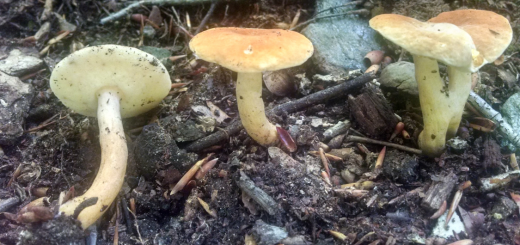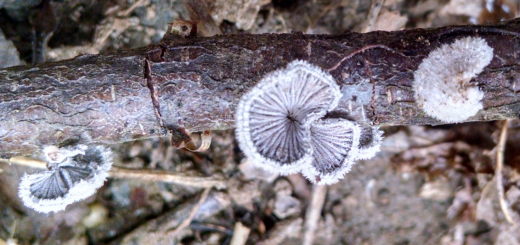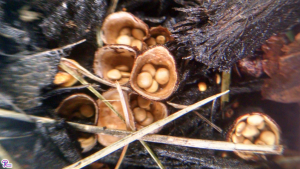#065: Trametes versicolor, the Turkey Tail [Archived]
Note: This is an archived post. Read the current version of this post here.
It is easy to see how this mushroom got its common name: the upper surface of the fan-shaped fruiting body sports rings of color that vary from gray to brown to reddish orange. In fresh specimens, the edge of the mushroom is white, making it look remarkably like the displayed tail of a wild turkey.
Trametes versicolor is a very common find on hardwood logs across the globe. The mushrooms are thin and usually have a radius of no more than 5cm. Despite their small size, they can be easily seen in the forest because of their bright colors and prolific fruiting. The individual mushrooms are fan-shaped to kidney-shaped to circular, depending where on the log the mushroom is found. Turkey Tail mushrooms grow out from a central point, which produces fan-shaped brackets on the side of a log or circular rosettes on the top of a log. T. versicolor loves to make mushrooms. It is common to find hundreds of Turkey Tail mushrooms covering a single log. In these close quarters, individual fruiting bodies often fuse together to make very long brackets. The flesh is thin, whitish, and leathery, so fresh Turkey Tails will bend quite a bit without breaking. Because of their leathery texture, you can usually find old mushrooms long after they stop growing. However, these older fruiting bodies are less colorful and often become green with algae. The underside of the mushroom is pure white (or a very light gray), which provides a nice contrast to the colorful upper surface. If you look closely, you will be able to see that the underside is covered with many, tiny pores (3-8 pores per millimeter). The pores, tough texture, thin flesh, and habitat indicate correctly that T. versicolor is a member of the polypores (phylum Basidiomycota, class Agaricomycetes, order Polyporales, family Polyporaceae).
Of course, the most striking feature of T. versicolor is its upper surface, which is characterized by concentric rings of color. The colors displayed by Turkey Tail mushrooms vary widely from individual to individual. The most common colors are varying shades of gray, brown, and orange, but one frequently finds mushrooms exhibiting red, blue, and/or green. It is interesting to note that all the mushrooms produced by a single individual will have the same banding pattern, making these rings a fungal fingerprint of sorts. Not only do these concentric zones vary in color, but they also vary in texture. Each ring has a specific texture, which can be smooth to velvety to fuzzy. You often find that fuzzier rings alternate with smoother ones. Furthermore, the zonate rings differ in relative elevation. Some rings will be higher than their neighbors, while others will be lower. Fresh specimens of the Turkey Tail can be spectacularly beautiful, especially when the fungus is producing mushrooms en masse.
Although Trametes versicolor is a distinctive mushroom, the amateur mushroom hunter may get confused by some look-alikes. Both Stereum ostrea (the False Turkey Tail FFF#144) and Lenzites betulina (the Gilled Polypore, FFF#168) grow as bracket fungi on wood and produce colorful, zonate mushrooms. However, a quick look at the underside of their mushrooms will show that neither one has pores: S. ostrea is completely smooth and L. betulina has gills. Trichaptum biforme (the Toothed Polypore) is zonate, but not quite so colorful. The margin is usually purplish and if you flip it over you will see a purplish, toothed surface (these teeth are actually eroded pores). A few other polypores with irregular pores have zonate rings and may be confused with the Turkey Tail at first glance. The regular, tiny pores of the Turkey Tail easily differentiate it from these look-alikes. There are also a number of other Trametes species that feature zonate caps and pores, but these lack at least one of the following: rings of strongly contrasting colors, a fuzzy cap surface, or tiny pores.
The Turkey Tail is usually considered inedible due to its leathery texture, but it is sometimes made into a tea. T. versicolor tea has long been used for its medicinal properties. The mushroom’s suspected medicinal benefits have received a fair amount of attention from researchers. A few compounds have been identified in T. versicolor which have anti-tumor properties. The most significant of these is PSK, which is sold commercially as Krestin. Research suggests that these compounds are not effective when ingested, so Turkey Tail tea probably won’t cure your cancer. T. versicolor has also been investigated for its bioremediation potential and for its potential use in biopulping. The Turkey Tail causes a white rot, which degrades lignin and leaves the cellulose. This makes it potentially useful in the paper-making process.
See Further:
http://www.mushroomexpert.com/trametes_versicolor.html
http://botit.botany.wisc.edu/toms_fungi/aug97.html
http://www.sierrapotomac.org/W_Needham/TrametesVersicolor_111223.htm
http://www.cancer.org/treatment/treatmentsandsideeffects/complementaryandalternativemedicine/dietandnutrition/coriolus-versicolor (this site uses an old scientific name for T. versicolor)



![#140: Morchella angusticeps, the Black Morel of Eastern North America [Archived]](https://www.fungusfactfriday.com/wp-content/themes/hueman/assets/front/img/thumb-medium-empty.png)





![#011: Characteristics of Kingdom Fungi [Archived]](https://www.fungusfactfriday.com/wp-content/themes/hueman/assets/front/img/thumb-small-empty.png)


3 Responses
[…] known as the “False Turkey Tail,” S. ostrea can be differentiated from the Turkey Tail (Trametes versicolor) fairly easily. S. ostrea is a crust fungus and therefore is smooth underneath, unlike T. […]
[…] mushrooms that can last throughout the winter. Of these, the most common are the Turkey Tail (Trametes versicolor) and Trichaptum biforme. Both of these are medium-sized wood decomposers often found covering […]
[…] above, Lenzites betulina looks a lot like the Turkey Tail (Trametes versicolor, FFF#065). When you flip the mushroom over, however, it looks completely different. L. betulina has a […]